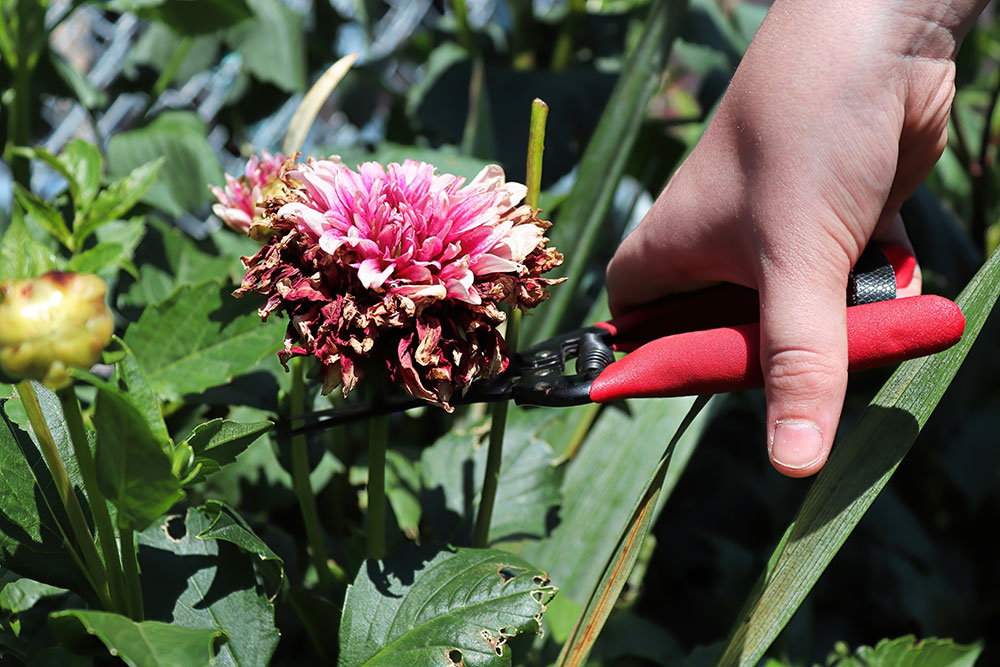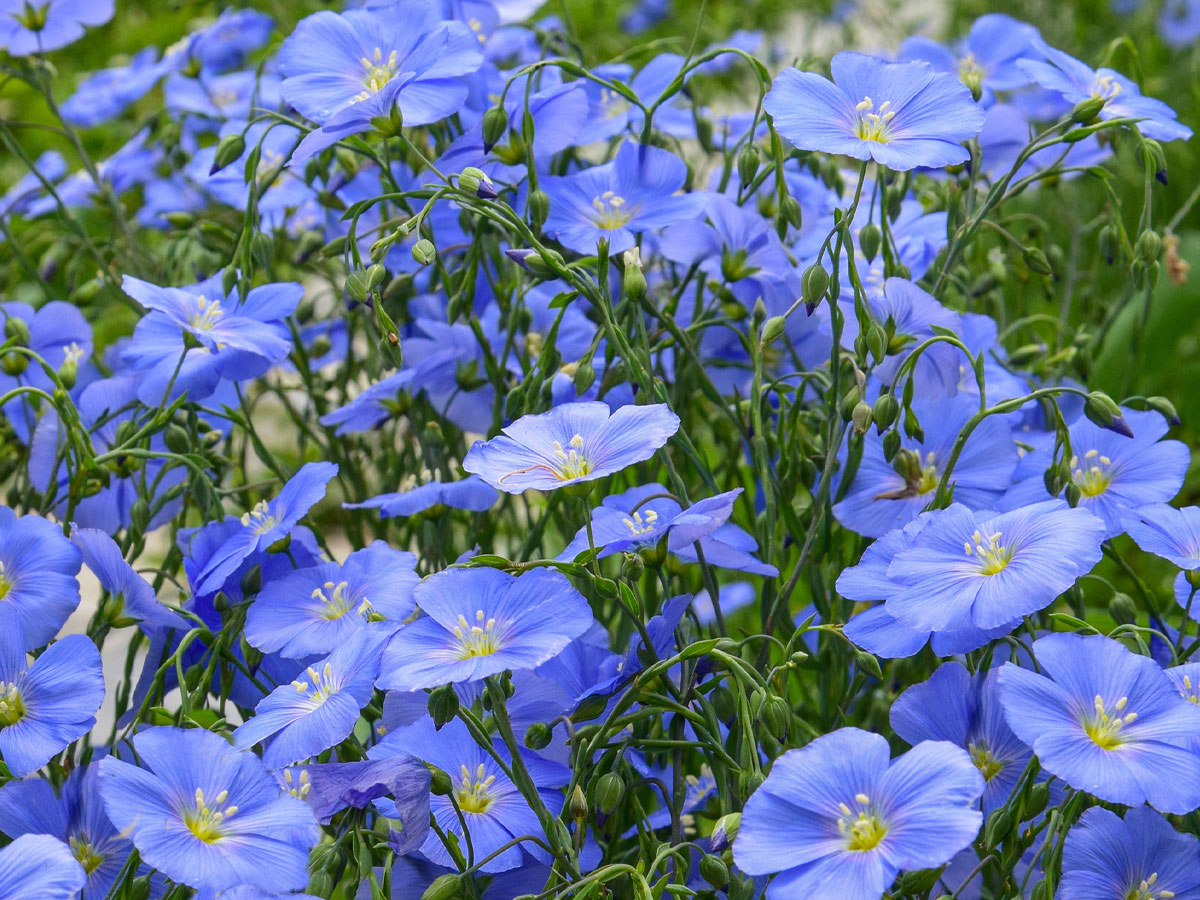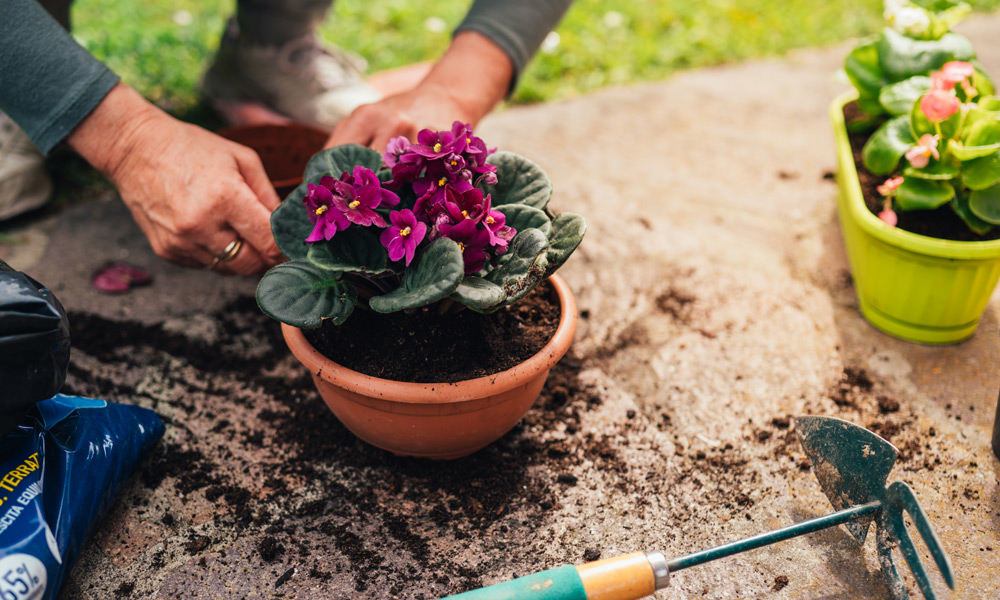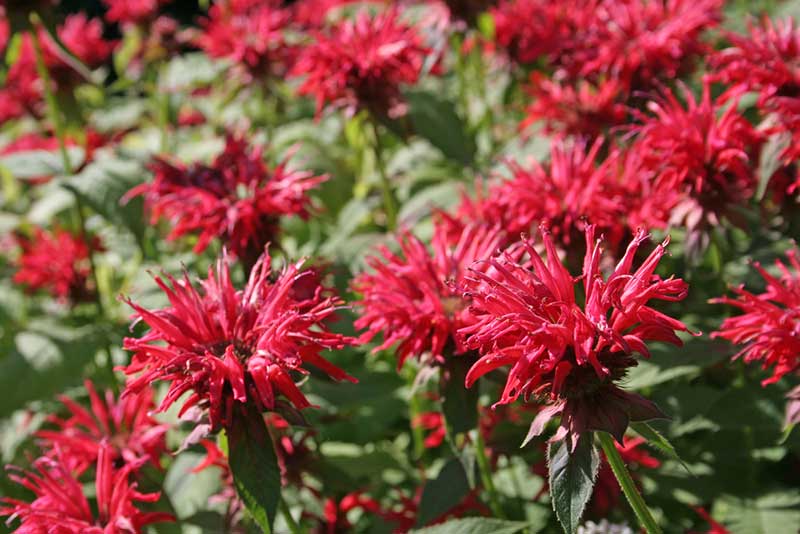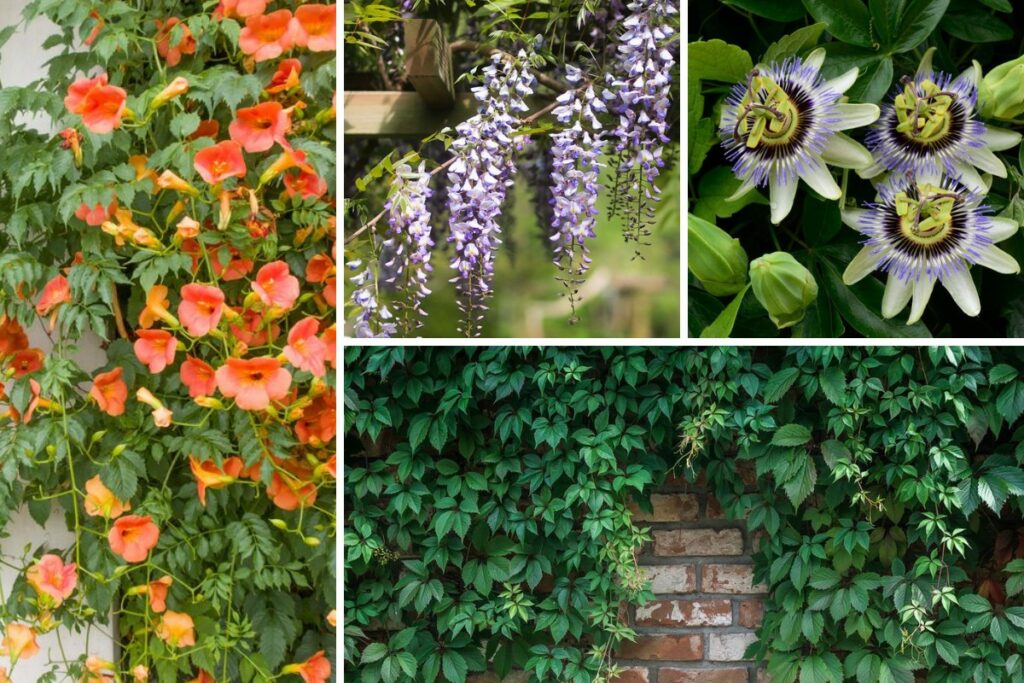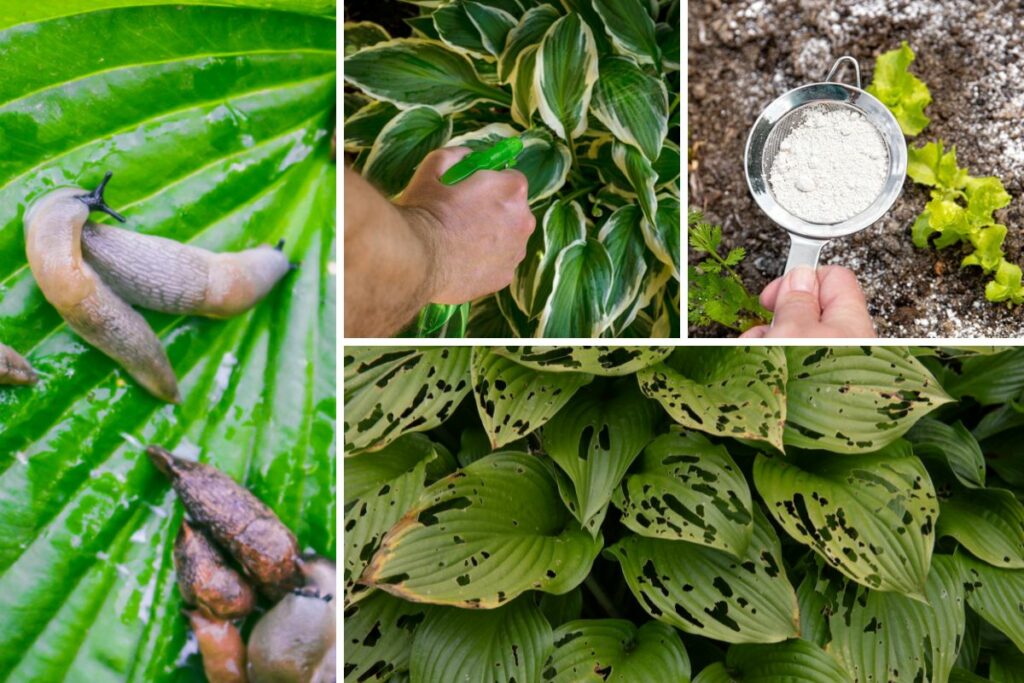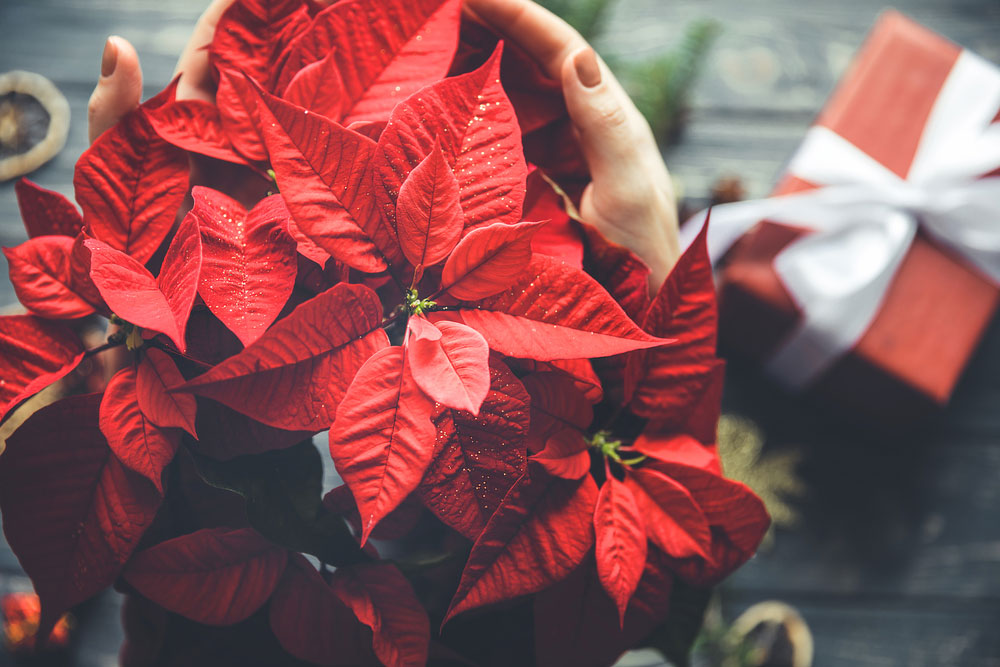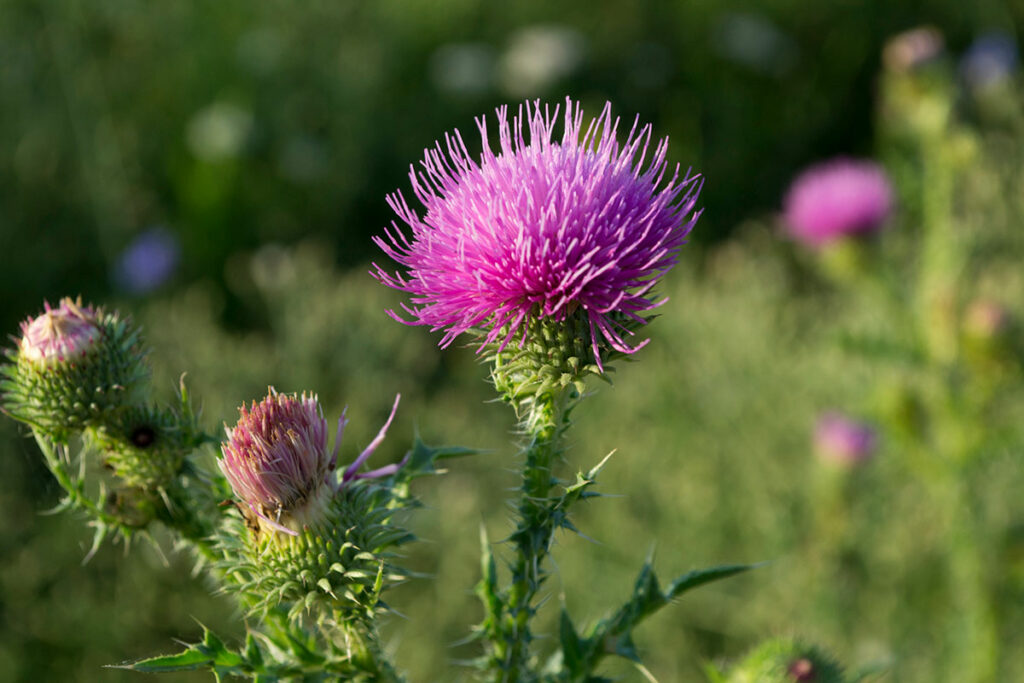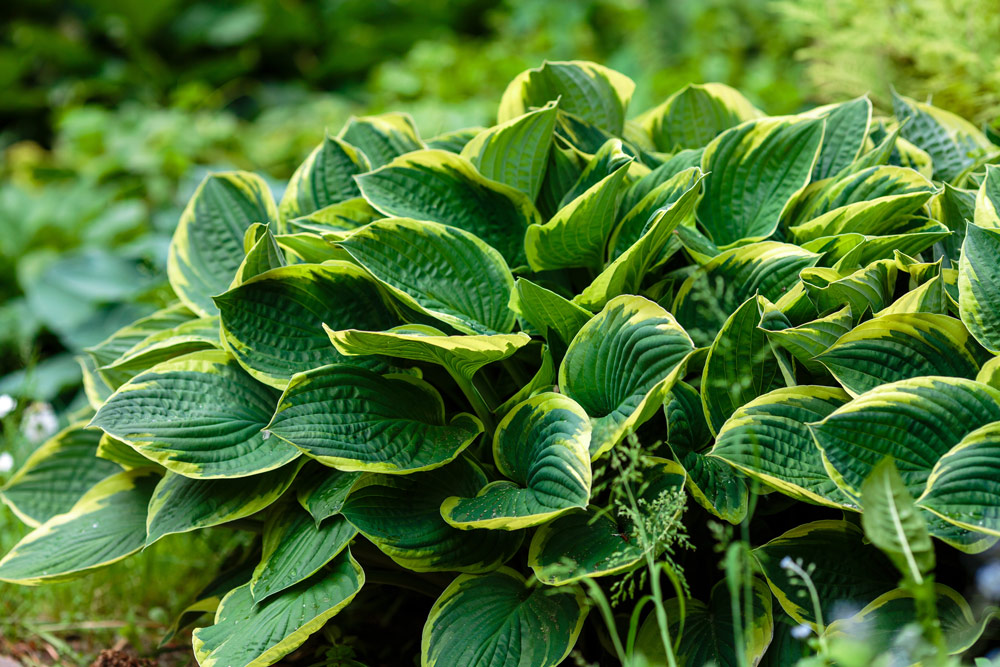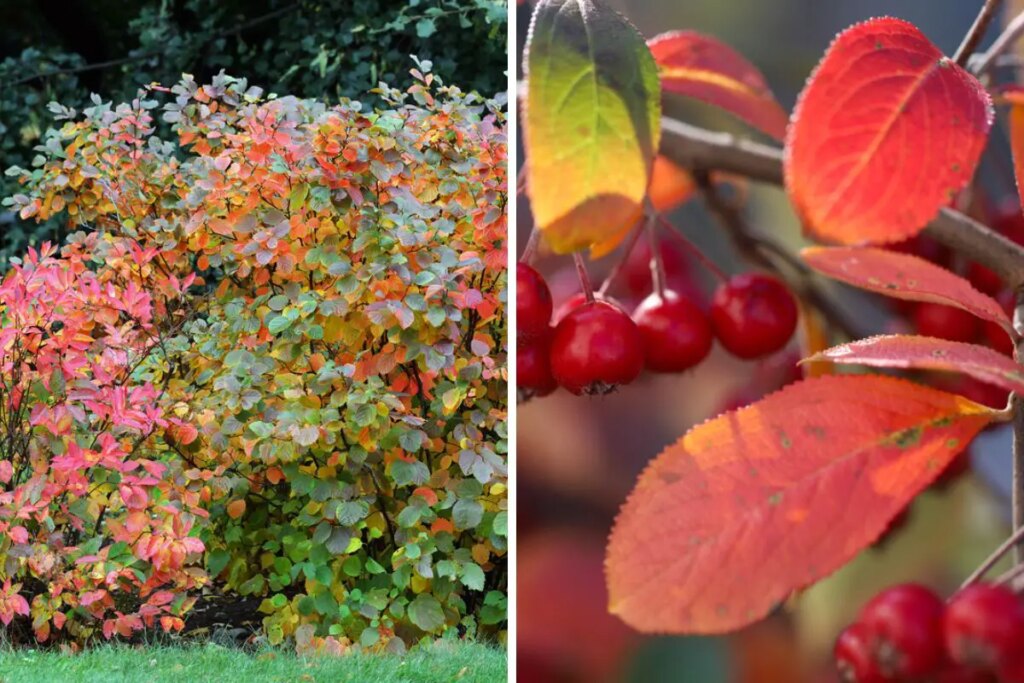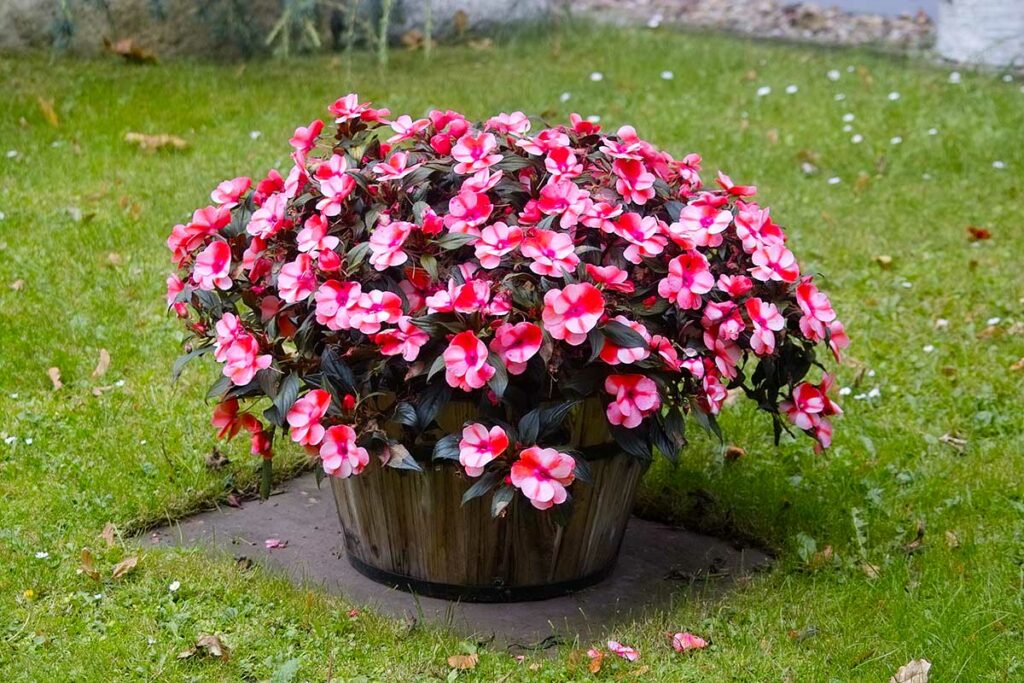
Fertilizing impatiens is an essential step in ensuring their vibrant colors and healthy growth. These popular flowering plants, known for their shade tolerance and abundant blooms, require proper nourishment to thrive.
By understanding the best practices for fertilizing impatiens, gardeners can enjoy their stunning blossoms throughout the season.
To achieve optimal impatiens growth, it’s crucial to select the right fertilizer and apply it at the appropriate time. Providing a consistent supply of nutrients will promote strong root systems, and, in turn, support more abundant blooms.
This article will explore valuable tips for fertilizing impatiens to help both novice and experienced gardeners cultivate beautiful, flourishing plants.
While fertilizer application may seem straightforward, it’s important to note that over-fertilizing can cause impatiens to produce more foliage and fewer flowers.
By following the advice presented in this article, gardeners can strike the right balance in their fertilization efforts, ultimately making the most of these delightful, colorful plants.
Types of Impatiens
Impatiens are a popular choice for gardeners due to their versatility and ability to provide stunning color throughout the season. There are several types of impatiens, each with their own unique characteristics and preferred growing conditions.
In this section, we will briefly introduce three popular types: New Guinea Impatiens, Busy Lizzies, and SunPatiens.
New Guinea Impatiens

New Guinea Impatiens are a hybrid species that are known for their large, vibrant flowers and distinct foliage. They can tolerate more sun than their relatives, the Busy Lizzies, but still prefer some shade. These plants are ideal for containers, hanging baskets, and garden beds. Some noteworthy features of New Guinea Impatiens include:
- Flower size: Large, up to 2-3 inches across
- Foliage: Green or variegated, with a slightly succulent texture
- Sun tolerance: Part shade to full sun (depending on the specific variety)
Busy Lizzies
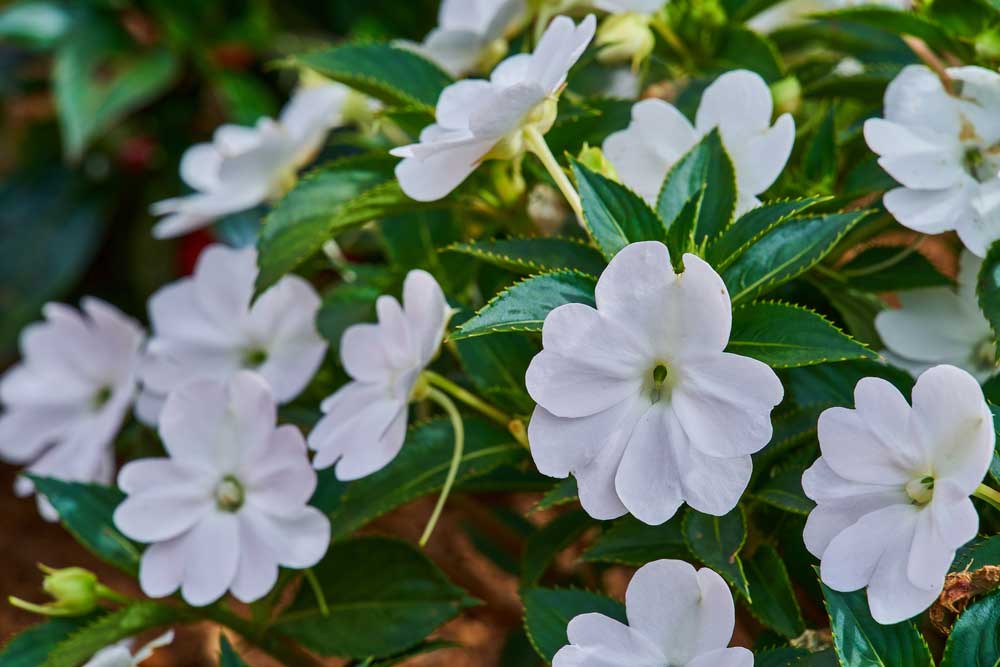
Busy Lizzies, also known as Impatiens walleriana, are a classic impatiens variety that typically thrive in shady conditions. They are popular for their continuous blooming, compact growth habit, and adaptability to various planting situations.
Here are some important characteristics of Busy Lizzies:
- Flower size: Smaller than New Guinea Impatiens, usually around 1-2 inches
- Foliage: Green, typically not variegated
- Sun tolerance: Prefers shade or part shade
SunPatiens
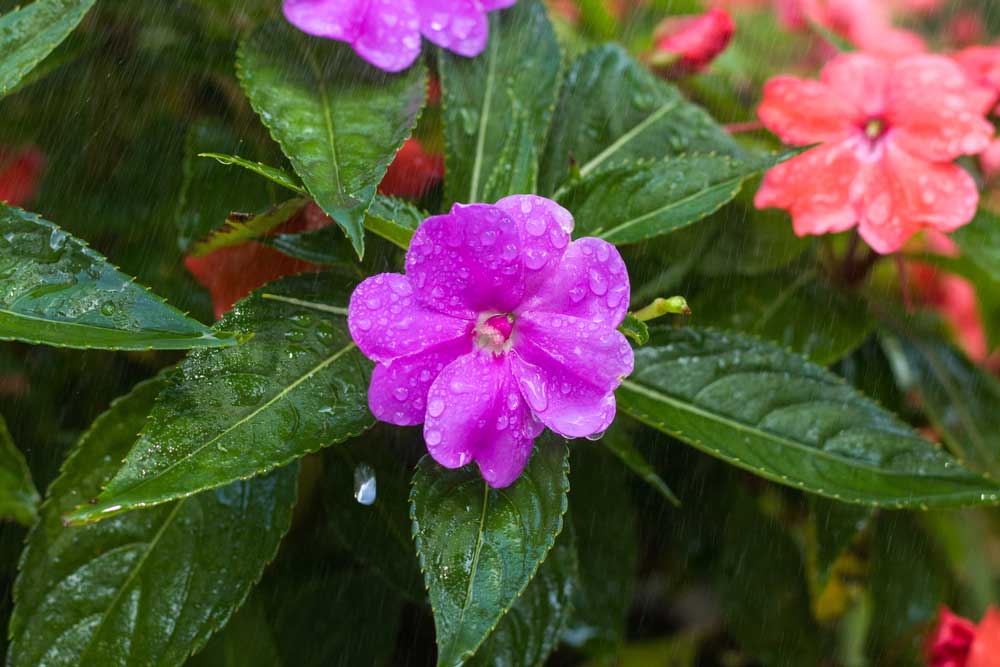
A relatively new addition to the impatiens family, SunPatiens are a patented hybrid bred for improved resistance to downy mildew and the ability to thrive in hot, sunny conditions. They grow rapidly and have a more expansive habit, creating an eye-catching display in the garden. Some distinctive traits of SunPatiens include:
- Flower size: Similar to New Guinea Impatiens, 2-3 inches across
- Foliage: Can be green or variegated, often with a thicker texture than other impatiens
- Sun tolerance: Full sun to part shade, heat and humidity tolerant
By understanding the differences between these three types of impatiens, you can select the best variety for your garden’s specific conditions, ensuring a colorful and healthy display.
Best Fertilizers
Impatiens will thrive when provided with the right type of fertilizer. Here are two main types of fertilizers that work best for your Impatiens:
Slow-Release Fertilizers
Slow-release fertilizers are a great option if you want to provide a steady supply of nutrients to your Impatiens over a longer period. There are several products available in the market, but some popular options include:
- Osmocote – This is a popular brand of slow-release fertilizer that contains a balanced mix of essential nutrients. It typically needs to be applied only once every 3-4 months.
- Miracle-Gro Shake ‘N Feed – This product is specifically designed for flowering plants like Impatiens. It releases nutrients slowly, over a 3-month period, and can simply be shaken around the base of the plants.
To use slow-release fertilizers, follow the manufacturer’s instructions on the packaging. Remember not to over-fertilize, as this can result in reduced blooming and foliage growth.
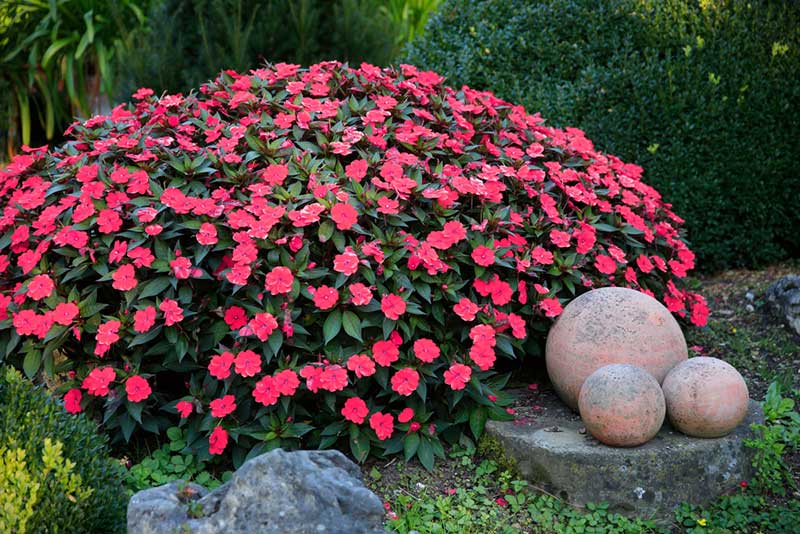
Water-Soluble Fertilizers
Water-soluble fertilizers are another excellent option for fertilizing Impatiens. They are quick-acting and need to be applied more frequently than slow-release fertilizers. Some top choices include:
- Miracle-Gro Water Soluble All Purpose Plant Food – This is a balanced fertilizer that can be mixed with water and applied to Impatiens every 7-14 days.
- Jack’s Classic Blossom Booster – This water-soluble fertilizer is designed to enhance flower production. It can be mixed with water and applied every 3-4 weeks.
When using water-soluble fertilizers, make sure to follow the recommended dosages on the label and to avoid applying the product in direct sunlight or on hot days, as this can cause stress on your plants.
Remember to always water your Impatiens well before and after fertilizing to help deliver nutrients to the roots and to avoid burning the foliage. With the right fertilizer choice, your Impatiens will produce vibrant and abundant blooms throughout the season.
Appropriate Fertilizing Schedule
Impatiens are generally easy to care for, but following a proper fertilizing schedule can help them flourish even more. Let’s discuss some friendly tips on how to create an appropriate schedule for fertilizing your impatiens.
Firstly, it’s essential to start fertilizing your impatiens when you initially plant them. This will ensure that they have the nutrients they need to grow strong and vibrant. Use a balanced, slow-release fertilizer, such as a 14-14-14 formula, by mixing it into the soil at the time of planting. This will provide your impatiens with essential nutrients for several weeks, promoting healthy growth.
Once your impatiens are established, you should switch to a more regular, monthly fertilizing schedule. During the growing season, typically from spring through early fall, apply a balanced, water-soluble fertilizer.
Examples of these can be a 20-20-20 or 10-10-10 formula. Be sure to follow the package instructions for the correct mixing ratio and application method, usually involving diluting the fertilizer in water and applying it to the soil.

In addition to monthly feedings, you can also choose to use a slow-release fertilizer for your impatiens, applied every 8-10 weeks during the growing season. This can simplify your fertilizing schedule while still ensuring that your plants receive the proper nutrients. Just remember not to apply slow-release fertilizers too close to the end of the growing season, as this can lead to nutrient runoff and waste.
One more thing to keep in mind is not to over-fertilize your impatiens. Too much fertilizer can lead to excessive growth and foliage at the expense of blooms.
If you notice that your plants are getting too leafy and not producing many flowers, scale back on your fertilization, focus on providing just the necessary nutrients, and give the plants a chance to balance their growth.
Following this fertilizing schedule, your impatiens should be well-nourished and bloom beautifully throughout the growing season.
Remember to always monitor the health and development of your plants, adjusting your fertilizing practices as needed to achieve the best results.
Application Techniques
Soil-Based
Impatiens require a well-balanced fertilizer to promote their growth and ensure vibrant blooms. When fertilizing impatiens using a soil-based method, it’s crucial to choose a slow-release granular fertilizer with an N-P-K (nitrogen-phosphorus-potassium) ratio of 10-10-10 or 14-14-14. Apply the fertilizer according to the manufacturer’s instructions, usually at the base of the plant ensuring the fertilizer doesn’t come into contact with the plant’s stems or leaves.
For a more efficient process, you can also create a fertilizer solution by mixing a water-soluble fertilizer with the recommended amount of water. Apply this solution every two weeks for consistent and healthy growth.
Foliar Feeding
Foliar feeding is another popular technique to provide your impatiens with nutrients. This method involves applying a liquid fertilizer directly to the plant’s leaves. To use foliar feeding, select a well-balanced, water-soluble fertilizer with a 20-20-20 or 15-30-15 N-P-K ratio. Mix the fertilizer with water as per the manufacturer’s guidelines, and apply it using a spray bottle or a garden sprayer.
It is best to apply foliar feeding early in the morning or late in the afternoon when the temperatures are cooler. Ensure an even coverage of the leaves, both on the top and bottom surfaces. Avoid spraying the flowers to reduce the risk of damage or discoloration. Also, do not apply foliar feeding during extreme weather conditions, such as high temperatures or intense sunlight, as it may cause leaf burns.
By employing these soil-based and foliar feeding techniques, you can supply your impatiens with the necessary nutrients for healthy growth and vibrant blooms. Remember to monitor their progress and adjust your fertilizer routine as needed.
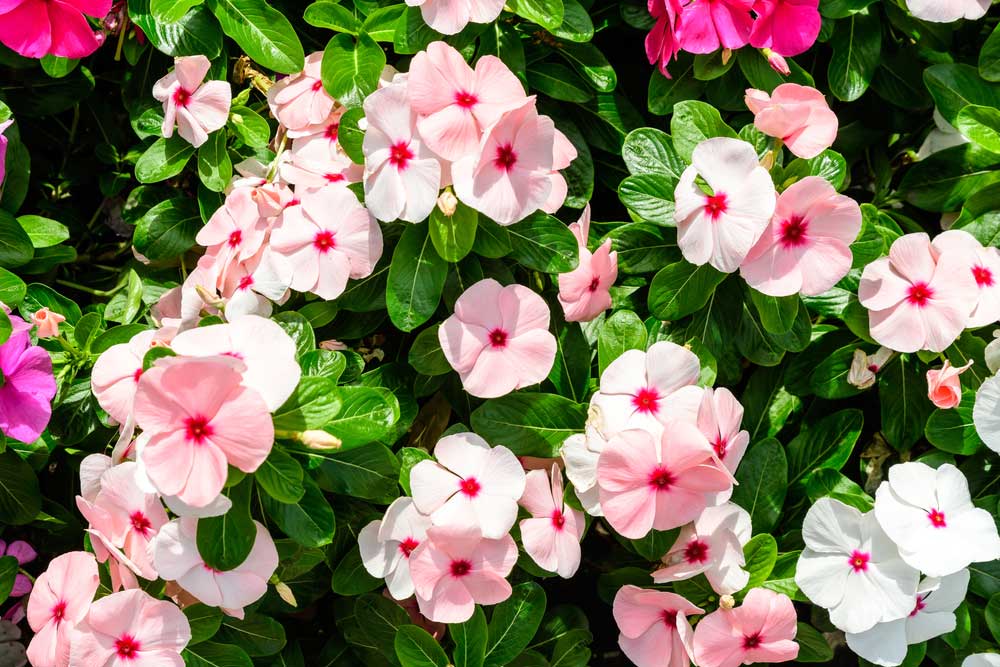
Monitoring Soil pH
Impatiens thrive in slightly acidic soil, with an optimal pH range of 6.0 to 6.5. To maintain this pH, it’s essential to monitor the soil conditions regularly. You can use a soil test kit, available at gardening stores, to measure the soil’s pH level. This friendly reminder will help you keep your impatiens healthy and vibrant.
If you find that the soil’s pH is not in the desired range, some amendments can help. For instance, if the pH is too low (acidic), adding lime can increase it, while adding sulfur can lower the pH if it’s too high (alkaline). Be sure to follow the manufacturer’s instructions on the packaging for the correct quantity and application method. It’s a good practice to test the soil again after a few weeks to ensure the pH has reached the intended level.
In addition to monitoring the soil pH, it’s important to pay attention to the overall quality of the soil. Impatiens prefer well-draining soil rich in organic matter. To achieve this, mix compost, aged manure, or peat moss into the planting area for better nutrient retention and soil structure. The addition of organic matter will also help buffer any fluctuations in the soil pH, creating a more stable environment for the impatiens.
By monitoring soil pH and making necessary adjustments, you will provide an ideal environment for your impatiens to flourish.
Caring for Impatiens Beside Fertilizing
Watering Requirements
Impatiens need consistent moisture to thrive. It’s essential to water them regularly, especially during hot and dry periods. A good rule of thumb is to water your impatiens at least two to three times per week. Always check the soil before watering, and aim to keep it evenly moist but not soggy. To maintain a friendly tone, be sure to not use any exaggerated or false claims:
- Water impatiens when the top 1-2 inches of soil feels dry
- Avoid letting the soil become bone dry, as this can harm the plant’s roots and affect its overall health
- Overwatering impatiens can lead to root rot and other diseases, so be cautious not to waterlog the plants
Proper Pruning
Regular pruning can help impatiens look neat, encourage bushy growth, and promote more flowering. Here’s a friendly guide on proper pruning for impatiens:
- Regular trimming: Snip off the tips of impatiens’ stems once every 2-3 weeks. This promotes branching and keeps the plant looking tidy.
- Deadheading: Remove faded or spent flowers by pinching them off at the base of the flower stem. Doing this helps encourage more blooms to form.
- Removing damaged growth: Gently trim any yellow, wilting, or damaged foliage and stems. This helps maintain the plant’s overall health and prevents the spread of diseases.
Practicing proper care when it comes to watering and pruning can significantly improve the health and appearance of your impatiens, ensuring they flourish in your garden.
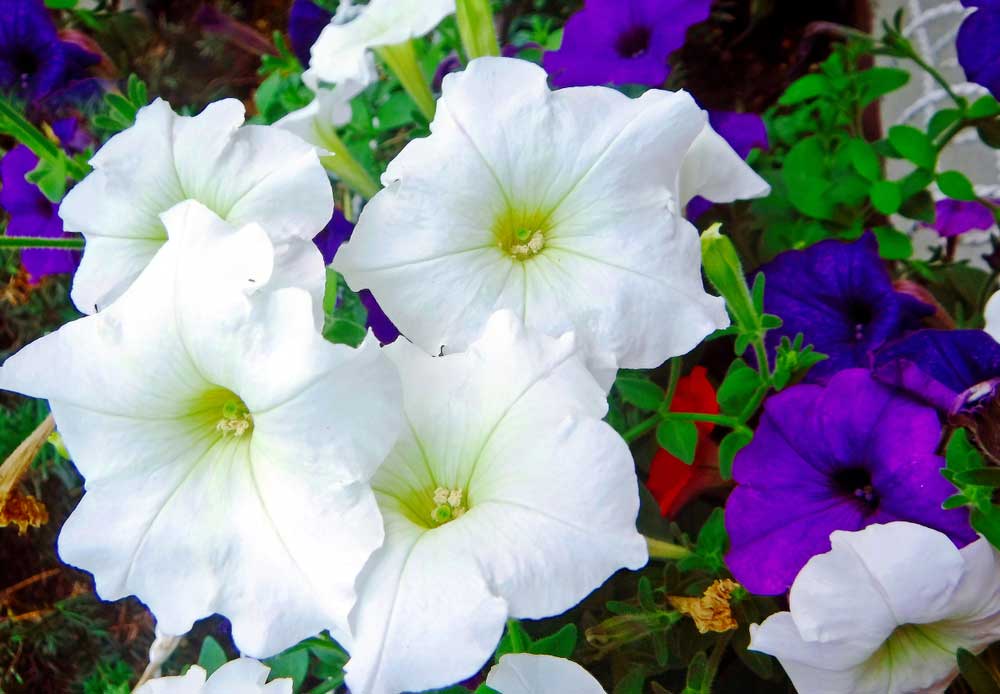
Signs of Over or Under-Fertilization
Impatiens are relatively easy to grow, but it’s important to pay attention to their health and know the signs of over or under-fertilization. In this section, we’ll briefly discuss the indicators that your impatiens might need a little extra care.
Over-Fertilization: Too much fertilizer can be harmful to impatiens, causing a range of issues. Some key signs of over-fertilization include:
- Yellowing leaves: Excess fertilizer can cause a buildup of salts in the soil, leading to leaf yellowing or browning. Be sure to flush the soil with fresh water to help alleviate this issue.
- Stunted growth: If your impatiens are not growing as expected, it could be due to an excess of nutrients. Cut back on the fertilizer and monitor their growth to ensure they return to normal.
- Weak and leggy stems: Impatiens with overly soft or elongated stems may be receiving too much fertilizer. Focus on providing appropriate lighting and reduce the amount of feed.
Under-Fertilization: On the other hand, impatiens that don’t receive enough nutrients may display the following symptoms:
- Pale leaves: If your impatiens have leaves that are pale green or yellow, they could be under-fertilized. Consider increasing the amount of fertilizer or adjusting the feeding schedule.
- Slow growth: Impatiens typically grow quickly, so slow growth may indicate a lack of necessary nutrients. Reevaluate your fertilizing routine to better meet their needs.
- Reduced flower production: Under-fertilized impatiens may produce fewer flowers than usual. Boosting the nutrients can help your impatiens produce more blooms throughout the season.
By paying attention to these signs, you can adjust your fertilizing routine accordingly to keep your impatiens healthy and thriving. Remember to always follow the recommended dosage on your fertilizer package and adjust as needed based on your plants’ needs.
Conclusion
Impatiens are popular and beautiful flowering plants that can brighten up any garden or indoor space. To ensure their vibrant colors and abundant growth, it’s essential to fertilize them properly. Here are some key tips for fertilizing impatiens to help them thrive:
- Choose the right fertilizer: Opt for a balanced granular, liquid, or slow-release fertilizer with an N-P-K ratio of 10-10-10 or 14-14-14. These balanced fertilizers provide the essential nutrients impatiens need for optimal growth.
- Timing is crucial: Schedule your fertilization routine during the growing season, typically from spring to early fall. Impatiens benefit from regular applications of fertilizer, so it’s best to establish a consistent schedule every 4-6 weeks.
- Application method matters: Whether using granular, liquid, or slow-release forms of fertilizer, be sure to apply it evenly and according to the product’s label instructions. For liquid fertilizers, watering the soil near the base of the plants is ideal, while granular and slow-release forms should be sprinkled around the plant but not touching the stems.
- Keep an eye on watering: Impatiens require well-drained soil with consistent moisture. Avoid over-watering or under-watering, as both can lead to poor nutrient absorption and plant health. Consider incorporating organic matter to improve soil drainage and retain moisture.
By following these helpful tips for fertilizing impatiens, you’ll enjoy a garden full of vibrant, healthy blooms.

